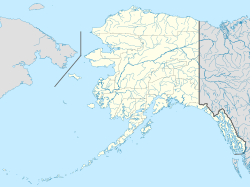Pilot Station, Alaska facts for kids
Quick facts for kids
Pilot Station
Tuutalgaq
|
|
|---|---|
| Country | United States |
| State | Alaska |
| Census Area | Kusilvak |
| Incorporated | October 6, 1969 |
| Area | |
| • Total | 1.88 sq mi (4.87 km2) |
| • Land | 1.61 sq mi (4.16 km2) |
| • Water | 0.28 sq mi (0.71 km2) |
| Elevation | 33 ft (10 m) |
| Population
(2020)
|
|
| • Total | 615 |
| • Density | 382.94/sq mi (147.86/km2) |
| Time zone | UTC-9 (Alaska (AKST)) |
| • Summer (DST) | UTC-8 (AKDT) |
| ZIP code |
99650
|
| Area code | 907 |
| FIPS code | 02-60750 |
| GNIS feature ID | 1407993 |
Pilot Station (Central Yupik: Tuutalgaq) is a city in Kusilvak Census Area, Alaska, United States. The population was 615 at the 2010 census, up from 568 in 2010, and up from 550 in 2000.
Contents
Geography
Pilot Station is located at 61°56′10″N 162°53′0″W / 61.93611°N 162.88333°W (61.936050, -162.883403), on the northern bank of the lower Yukon River, approximately eighty miles ('as the crow flies') from the Bering Sea.
According to the United States Census Bureau, the city has a total area of 2.3 square miles (6.0 km2), of which 1.7 square miles (4.4 km2) is land and 0.6 square miles (1.6 km2) (25.55%) is water.
Demographics
| Historical population | |||
|---|---|---|---|
| Census | Pop. | %± | |
| 1890 | 103 | — | |
| 1920 | 145 | — | |
| 1930 | 87 | −40.0% | |
| 1940 | 39 | −55.2% | |
| 1950 | 52 | 33.3% | |
| 1960 | 219 | 321.2% | |
| 1970 | 290 | 32.4% | |
| 1980 | 325 | 12.1% | |
| 1990 | 463 | 42.5% | |
| 2000 | 550 | 18.8% | |
| 2010 | 568 | 3.3% | |
| 2020 | 615 | 8.3% | |
| U.S. Decennial Census | |||
Pilot Station first appeared on the 1890 U.S. Census as the unincorporated Eskimo (Yup'ik) village of "Ankahchagmiut." It did not report again until 1920, then as Pilot Station. It formally incorporated in 1969.
At the 2020 census, there were 615 people, 152 households and 73 families residing in the city. The population density was 326.2 inhabitants per square mile (125.9/km2). There were 152 housing units at an average density of 74.7 per square mile (28.8/km2). The racial makeup was 97.7% Native American (Yup'ik), 1.3% White and 2.1% from two or more races.
There were 152 households, of which 61.8% had children under the age of 18 living with them, 34.2% were married couples living together, 9.9% had a female householder with no partner present, 5.3% had a male with no partner present. 2.6% had someone living alone who was 65 years of age or older.
41.5% of the population were under the age of 18, 58.5% from 18 and over, and 4.9% who were 65 years of age or older. The median age was 24.4 years. There were 299 females, and 316 males.
{The median household income was $31,071 and the median family income was $27,411. Males had a median income of $27,917 and females $16,667. The per capita income was $7,311. About 25.3% of families and 28.7% of the population were below the poverty line, including 26.0% of those under age 18 and 28.1% of those age 65 or over.} [2000 data]
Education
K-12 students attend Pilot Station School, operated by the Lower Yukon School District.
See also
 In Spanish: Pilot Station para niños
In Spanish: Pilot Station para niños


